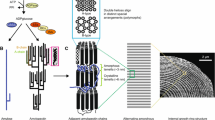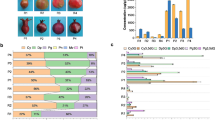Summary
The alc mutation affects the ripening and storability of tomato fruit. The alteration of fruit color in alc lines is due to a reduction in total pigment and a reduction in lycopene relative to total carotinoids. Polygalacturonase (PG) activity is reduced to less than 5% of normal, and the isozymes PG2a and PG2b are absent in alc fruit. The level of anti-PG precipitable proteins is also reduced to less than 5% of normal. Total polyA + mRNA is not significantly reduced in ripening alc fruit, but hybridization of polyA + mRNA to different ripening-related cDNA clones showed that specific mRNAs are present at reduced levels in the mutant. Specific mRNA levels were reduced to 10%–80% of normal levels, depending on the cDNA clone used as the probe. PG mRNA was present at 5%–10% of the normal level.
All effects of alc on fruit ripening are relived in the line Alcobaca-red, which arose spontaneously from the original alc line, Alcobaca. The Alcobaca-red trait segregates as a single dominant trait at or very near the alc locus, and it is probably the result of a reverse mutation at the alc locus.
The chromosomal locations of regions homologous to 5 ripening-related cDNA probes were determined. Regions homologous to 4 of these probes map to chromosomes other than chromosome 10, indicating that the effects of alc are transactive. A cDNA clone for PG was homologous to only one chromosomal region. This region is located on chromosome 10, which is also the chromosome on which alc and nor are located.
Similar content being viewed by others
References
Ali ZM, Brady CJ (1982) Purification and characterization of the polygalacturonase of tomato fruits. Aust J Plant Physiol 9:155–169
Bernatzky R, Tanksley S (1986) Towards a saturated linkage map in tomato based on isozymes and random cDNA sequences. Genetics 112(4):887–898
Brady CJ (1987) Fruit ripening. Ann Rev Plant Phys 35:155–178
Brady DJ, MacAlpine G, McGlasson WB, Ueda Y (1982) Polygalacturonase in tomato fruits and the induction of ripening. Aust J Plant Physiol 9:171–178
Brady DJ, Meldrum SK, McGlasson WB (1983) Differential accumulation of molecular forms of polygalacturonase in tomato mutants. J Food Biochem 7:7–14
Crookes P, Grierson D (1983) Plant Physiol 72:1088–1093
Davies BH (1965) Analysis of carotenoid pigments. In: Goodwin TW (ed) Chemistry and biochemistry of plant pigments. Academic Press, NY pp 489–532
DellaPenna D, Alexander D, Bennett A (1986) Molecular cloning of tomato fruit polygalacturonase: Analysis of polygalacturonase mRNA levels during ripening. Proc Natl Acad Sci USA 83:6420–6424
DeSwardt GH, Swanepoel JH, Duvenage AJ (1973) Relationships between changes in ribosomal RNA, total protein synthesis and respiration climacteric in pericarp tissue of tomato. Z Pflanzenphysiol 70:358–363
Grierson D (1985) Gene expression in ripening tomato fruit. CRC Crit Rev Plant Sci 3:113–132
Grierson D, Tucker GA (1983) Timing of ethylene and polygalacturonase synthesis in relation to the control of tomato fruit ripening. Planta 157:174–179
Grierson D, Slater A, Maunders MJ, Crookes P, Tucker GA, Schuch W, Edwards K (1985a) Regulation of the expression of tomato fruit ripening genes: The involvement of ethylene. In: Roberts JA, Tucker GA (eds) Ethylene and plant development. Butterworth, Oxford, pp 147–161
Grierson D, Slater A, Speirs J, Tucker GA (1985b) The appearance of polygalacturonase mRNA in tomatoes: One of a series of changes in gene expression during development and ripening. Planta 163:263–271
Grierson D, Tucker GA, Keen J, Ray J, Bird CR, Schuch W (1986a) Sequencing and identification of a cDNA clone for tomato polygalacturonase. Nucleic Acids 14:8595–8603
Grierson D, Maunders MJ, Slater A, Ray J, Bird CR, Schuch W, Holdsworth MJ, Tucker GA, Knapp JE (1986b) Gene expression during tomato ripening. Philas Trans R Soc London B 314:399–410
Hobson GE (1964) Polygalacturonase in normal and abnormal tomato fruit. Biochem J 92:324–332
Hobson GE (1980) Effect of the introduction of nonripening mutant genes on the composition and enzyme content of tomato fruit. J Sci Food Agric 31:578–584
Holdsworth M, Bird C, Ray J, Schuch W, Grierson D (1987) Structure and expression of an ethylene related mRNA from tomato. Nuc Acids Res 15:731–739
Iki K, Sekiguchi K, Kusata K, Tada T, Nakagawa H (1978) Immunological properties of B fructofuranosidase from ripening fruit. Phytochem 17:311–312
Maniatis T, Fritsch EF, Sambrook J (1982) Molecular cloning: A laboratory manual. Cold Spring Harbor Laboratory. Cold Spring Harbor/NY
Mansson PE, Hsu D, Stalker D (1985) Characterization of fruit specific cDNA's from tomato. Molec Gen Genet 200: 356–361
Maunders MJ, Holdsworth MJ, Slater A, Knapp JE, Bird CR, Schuch W, Grierson D (1987) Ethylene stimulates the accumulation of ripening-related mRNAs in tomatoes. Plant Cell Environ 10:177–184
Mutschler MA (1984a) Inheritance and linkage of Alcobaca ripening mutant in tomato. Am J Hortic Sci 109:500–503
Mutschler MA (1984b) Ripening and storage characteristics of the Alcobaca ripening mutant in tomato. Am J Hortic Sci 109:504–507
Ouchterlony O (1962) Diffusion-in-gel methods for immunological analysis II. Prog Allergy 6:30–154
Rattanapanone N, Grierson D, Stein M (1977) Ribonucleic acid metabolism during the development and ripening of tomato fruits. Phytochemistry 16:629–633
Rattanapanone N, Speirs J, Grierson D (1978) Evidence for changes in messenger RNA content related to tomato fruit ripening. Phytochemistry 17:1485–1486
Slater A, Maunders MJ, Edwards K, Schuch W, Grierson D (1985) Isolation and characterization of cDNA clones for tomato polygalacturonase and other ripening-related proteins. Plant Molec Biol 5:137–147
Speirs J, Brady C, Grierson D, Ali ZM (1984) The sequence of changes in ribosome organization and mRNA abundance in ripening tomato fruits. Aust J Plant Physiol 11:225–233
Thomas RL, Jen JJ (1975) Phytochrome mediated carotinoid biosynthesis in ripening tomatoes. Plant Physiol 56:452–453
Tigchelaar EC, McGlasson WB, Buescher RW (1978) Genetic regulation of tomato fruit ripening. Hort Science 13:508–513
Tucker GA, Grierson D (1982) Synthesis of polygalacturonase during tomato fruit ripening. Planta 155:64–67
Tucker GA, Robertson NG, Grierson D (1980) Changes in polygalacturonase isoenzymes during the ripening of normal and mutant tomato fruit. Eur J Biochem 112:119–124
Tucker GA, Robertson NG, Grierson D (1981) The conversion of tomato fruit polygalacturonase isoenzyme 2 into isoenzyme 1 in vitro. Eur J Biochem 115:87–90
Author information
Authors and Affiliations
Additional information
Communicated by P. Maliga
Rights and permissions
About this article
Cite this article
Mutschler, M., Guttieri, M., Kinzer, S. et al. Changes in ripening-related processes in tomato conditioned by the alc mutant. Theoret. Appl. Genetics 76, 285–292 (1988). https://doi.org/10.1007/BF00257857
Received:
Accepted:
Issue Date:
DOI: https://doi.org/10.1007/BF00257857




